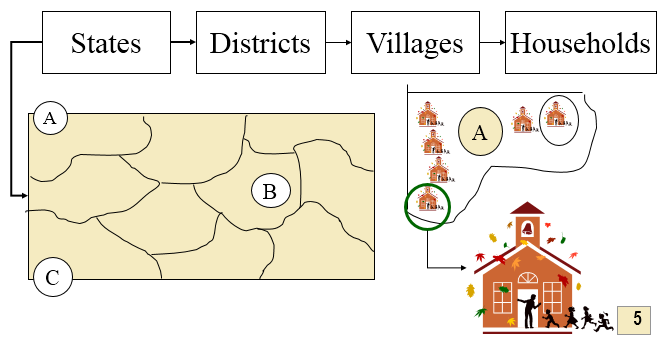Multi-stage sampling
Multi-stage sampling (also known as multi-stage cluster sampling) is a more complex form of cluster sampling which contains two or more stages in sample selection. In simple terms, in multi-stage sampling large clusters of population are divided into smaller clusters in several stages in order to make primary data collection more manageable. It has to be acknowledged that multi-stage sampling is not as effective as true random sampling; however, it addresses certain disadvantages associated with true random sampling such as being overly expensive and time-consuming.
Application of Multi-Stage Sampling: an Example
Contrary to its name, multi-stage sampling can be easy to apply in business studies. Application of this sampling method can be divided into four stages:
- Choosing sampling frame, numbering each group with a unique number and selecting a small sample of relevant discrete groups.
- Choosing a sampling frame of relevant discrete sub-groups. This should be done from relevant discrete groups selected in the previous stage.
- Repeat the second stage above, if necessary.
- Choosing the members of the sample group from the sub-groups using some variation of probability sampling.
Let’s illustrate the application of the stages above using a specific example.
Your research objective is to evaluate online spending patterns of households in the US through online questionnaires. You can form your sample group comprising 120 households in the following manner:
- Choose 6 states in the USA using simple random sampling (or any other probability sampling).
- Choose 4 districts within each state using systematic sampling method (or any other probability sampling).
- Choose 5 households from each district using simple random or systematic sampling methods. This will result in 120 households to be included in your sample group.
Advantages of Multi-Stage Sampling
- Effective in primary data collection from geographically dispersed. population when face-to-face contact in required (e.g. semi-structured in-depth interviews)
- Cost-effectiveness and time-effectiveness.
- High level of flexibility.
Disadvantages of Multi-Stage Sampling
- High level of subjectivity.
- Research findings can never be 100% representative of population.
- The presence of group-level information is required.
My e-book, The Ultimate Guide to Writing a Dissertation in Business Studies: a step by step approach contains a detailed, yet simple explanation of sampling methods. The e-book explains all stages of the research process starting from the selection of the research area to writing personal reflection. Important elements of dissertations such as research philosophy, research approach, research design, methods of data collection and data analysis are explained in this e-book in simple words. John Dudovskiy


